One suggestion they got from the Kentucky community organizers: Have events that are fun and bring people together, something that has worked in Covington.
“Some of our longtime, tried-and-true neighborhood leaders, they get so darn serious about things,” said Rachel Hastings of Covington. “They think that Covington is the only place on the planet, and we’re like, ‘Let’s also remember to have some fun, because if you’re just always so serious and not having fun, then other folks are going to be like, ‘Why should I be involved with those people?’”
Like Hamilton’s 17 Strong “micro-grants” of up to $3,000 for a neighborhood that have been offered since last year, the Center for Great Neighborhoods for about 10 years has offered grants of up to $5,000 for community-building projects. A top goal of Covington grants, like those in Hamilton, is to help engage new people in each neighborhood.
Many neighborhoods have worked with artists to build mosaics identifying their neighborhoods at entry points. Some have created newsletters, websites or walking trails, and improved parks or other public property.
“It was really anything that they wanted to do to improve their community,” Hastings said.
But more recently, the Northern Kentucky organization has distributed about 140 “nano-grants” of up to $250 to individuals or groups that are much easier to get that also help build friendships among neighbors.
One woman used a $250 grant to provide art tours for the blind, with the money helping provide bus transportation around the city. The same resident later used a larger grant to buy a new printer, to create Braille menus for local restaurants. In exchange for that service, the restaurants gave tours for the blind.
More recently, an 8-year-old girl sought a nano-grant to create a tiny free library.
“If we fund something for $250 and it fails? Oh, well, it’s 250 bucks,” Hastings said, noting the nano grants do not come from city or other public funds, so there isn’t blowback from taxpayers.
Some grants have turned out to be more fun than expected — and drew people from across the region to Covington.
Most notably among those was the funding of a project that brought a farmer’s goats to Covington’s Goebel Park, located just west of Interstate 71/75 near the city’s MainStrasse neighborhood, where Covington hosts Oktoberfests. The idea was for the goats to spend the spring through fall eating honeysuckle, an invasive plant that was disguising criminal activities in some parts of the park.
“They became this big deal, because they had goat T-shirts and hats, and people from all over the region were coming to MainStrasse to see the Goebel Goats,” Hastings said. “On their way up and down the hill, they would stop to get a cup of coffee, an ice cream. So business owners were telling us, ‘I’m seeing increased activity because of those goats.’”
A pen of chickens and community garden also have inspired conversation and community in an area of Covington’s West Side neighborhood. The area, located about a block from the Center for Great Neighborhoods building, now is experiencing a significant rebound, although a number of empty buildings remain.
The Center for Great Neighborhoods, which is largely funded by foundations and government grants, also has rehabbed about 40 Covington homes through the years.
Hamilton’s 17 Strong program has a 12-member board,with four members from each neighborhood type: urban, traditional and suburban. A primary goal of Hamilton’s community-building effort is to create a sense of place in the city with safe, clean and engaged neighborhoods.
“We’re all sort of looking for what that next evolution is of this, but it’s been a fun ride,” Brandon Saurber, Hamilton’s director of strategy and information development, told the Covington community builders during the meeting.
Also making the trip across the Ohio River were Hamilton Council Member Kathleen Klink, Lindenwald neighborhood leader Frank Downie and another 17 Strong leader Joanne Wallisch.
BY THE NUMBERS
Hamilton and Covington have similar demographics:
- The per-capita income in Hamilton is $21,386, compared with $21,108 in Covington
- In Hamilton, 22.1 percent lived in poverty, compared with 27.7 percent in Covington
- Some 56.9 percent of Hamilton housing is owner-occupied, compared with 49.3 percent in Covington
- Hamilton has a higher percentage of high-school graduates above the age of 25 — 85.2 percent to 83 percent — but a lower percentage of residents with bachelor's degrees or higher: 14.9 percent to 20.7 percent
About the Author
